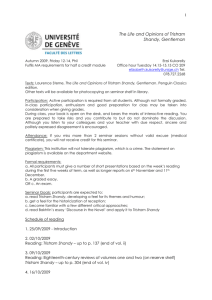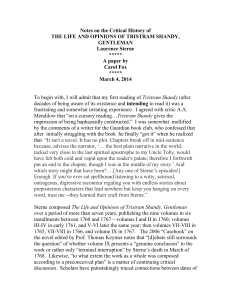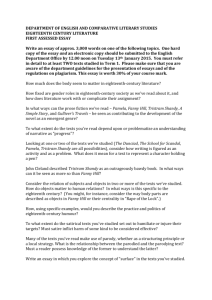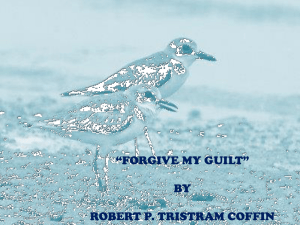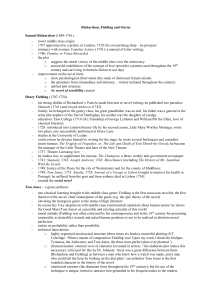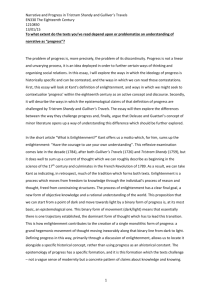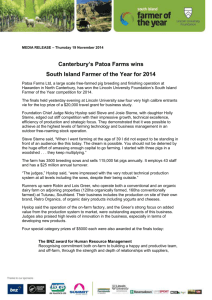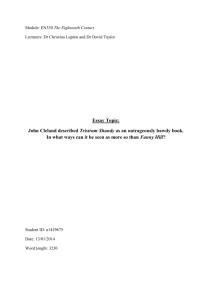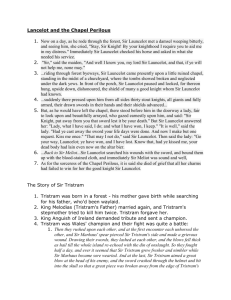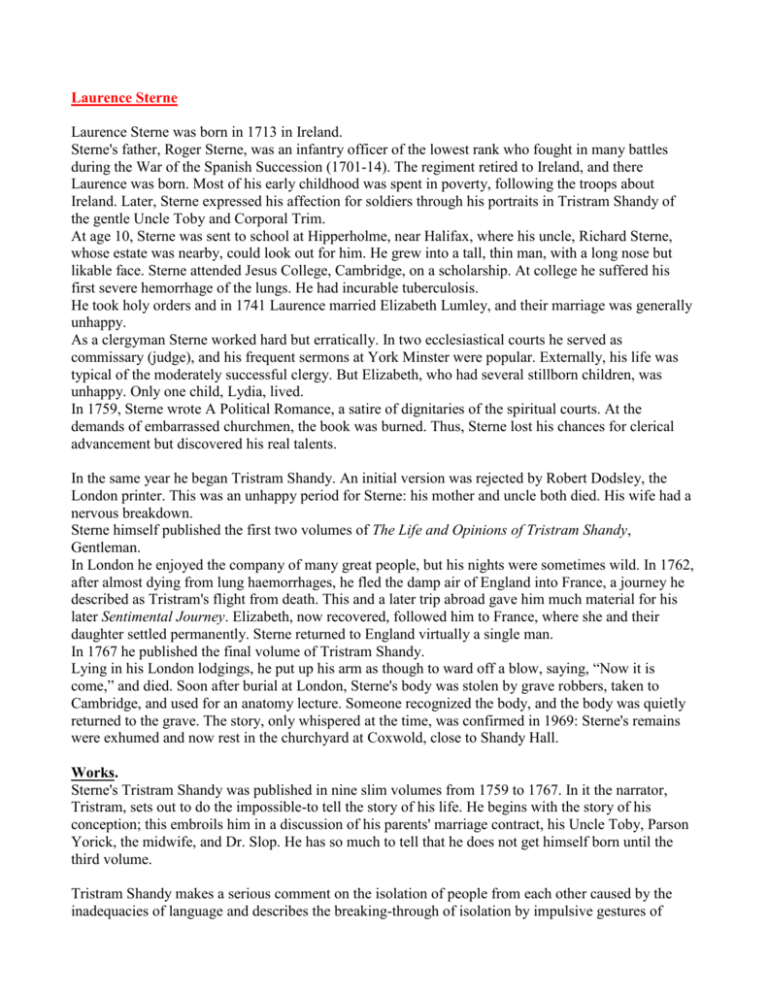
Laurence Sterne
Laurence Sterne was born in 1713 in Ireland.
Sterne's father, Roger Sterne, was an infantry officer of the lowest rank who fought in many battles
during the War of the Spanish Succession (1701-14). The regiment retired to Ireland, and there
Laurence was born. Most of his early childhood was spent in poverty, following the troops about
Ireland. Later, Sterne expressed his affection for soldiers through his portraits in Tristram Shandy of
the gentle Uncle Toby and Corporal Trim.
At age 10, Sterne was sent to school at Hipperholme, near Halifax, where his uncle, Richard Sterne,
whose estate was nearby, could look out for him. He grew into a tall, thin man, with a long nose but
likable face. Sterne attended Jesus College, Cambridge, on a scholarship. At college he suffered his
first severe hemorrhage of the lungs. He had incurable tuberculosis.
He took holy orders and in 1741 Laurence married Elizabeth Lumley, and their marriage was generally
unhappy.
As a clergyman Sterne worked hard but erratically. In two ecclesiastical courts he served as
commissary (judge), and his frequent sermons at York Minster were popular. Externally, his life was
typical of the moderately successful clergy. But Elizabeth, who had several stillborn children, was
unhappy. Only one child, Lydia, lived.
In 1759, Sterne wrote A Political Romance, a satire of dignitaries of the spiritual courts. At the
demands of embarrassed churchmen, the book was burned. Thus, Sterne lost his chances for clerical
advancement but discovered his real talents.
In the same year he began Tristram Shandy. An initial version was rejected by Robert Dodsley, the
London printer. This was an unhappy period for Sterne: his mother and uncle both died. His wife had a
nervous breakdown.
Sterne himself published the first two volumes of The Life and Opinions of Tristram Shandy,
Gentleman.
In London he enjoyed the company of many great people, but his nights were sometimes wild. In 1762,
after almost dying from lung haemorrhages, he fled the damp air of England into France, a journey he
described as Tristram's flight from death. This and a later trip abroad gave him much material for his
later Sentimental Journey. Elizabeth, now recovered, followed him to France, where she and their
daughter settled permanently. Sterne returned to England virtually a single man.
In 1767 he published the final volume of Tristram Shandy.
Lying in his London lodgings, he put up his arm as though to ward off a blow, saying, “Now it is
come,” and died. Soon after burial at London, Sterne's body was stolen by grave robbers, taken to
Cambridge, and used for an anatomy lecture. Someone recognized the body, and the body was quietly
returned to the grave. The story, only whispered at the time, was confirmed in 1969: Sterne's remains
were exhumed and now rest in the churchyard at Coxwold, close to Shandy Hall.
Works.
Sterne's Tristram Shandy was published in nine slim volumes from 1759 to 1767. In it the narrator,
Tristram, sets out to do the impossible-to tell the story of his life. He begins with the story of his
conception; this embroils him in a discussion of his parents' marriage contract, his Uncle Toby, Parson
Yorick, the midwife, and Dr. Slop. He has so much to tell that he does not get himself born until the
third volume.
Tristram Shandy makes a serious comment on the isolation of people from each other caused by the
inadequacies of language and describes the breaking-through of isolation by impulsive gestures of
sympathy and love. A second great theme of the novel is that of time-the discrepancy between clock
time and time as sensed, the impinging of the past upon the present, the awareness that a joyous life
inexorably leads to death. Modern commentators regard Tristram Shandy as the ancestor of
psychological and stream-of-consciousness fiction.
Sterne's second and last novel, A Sentimental Journey, is the story of Yorick's travels through France;
Sterne did not live to complete the part on Italy. He called it a “sentimental” journey because the point
of travel was not to see sights or visit art collections, but to make meaningful contact with people. A
Sentimental Journey was translated into many languages, but the translations tended to lose the comedy
and emphasize the sentiments.
TRISTRAM SHANDY
CHARACTERS
Tristram
The title of the book, Life and Opinions of Tristram Shandy, reveals the two identities that Tristram
Shandy has in the book . Surprisingly, the Tristram for whom this story was written makes few
appearances, and when we do see this Tristram,he often appears through the actions and reactions of
another character. We do not see Tristram's life directly, but rather, accompanying other characters like
Trim, his father, his mother, Dr. Slop, and Toby, etc. For example, we hear of Tristram's nose being
crushed only when his father finds out. Ironically, the narrator spends more time on his father's reaction
to the accident and other's reactions surrounding Tristram than does he spend with Young Tristram.
This does not mean that we do not get a good look into Tristram Shandy's life. The book is truly about
one Tristram Shandy, not the young Tristram Shandy but, rather, the author. Tristram-the-narrator's
presence is greatly felt throughout the book. We see into Tristram's life not by the narrator telling about
it, but through the views of Tristram-the-author. Through Tristram's many digressions on various topics
such as: noses, which are often seen as metaphoric penis, many odd stories on characters like Yorick,
and his discussions on different people's HOBBY HORSES we see directly into the life of Tristram
Shandy.
Uncle Toby
Uncle Toby, in Tristram Shandy, is known as one of the classic characters in English literature. Uncle
Toby is the antithesis of Walter Shandy, Tristram's intellectual father. If Walter Shandy were cold
reason, Toby would be hot passion. Compassionate and sympathetic, Toby is the perfect sentimentalist.
His dedication to his HOBBY-HORSE, building fortifications and knowledge in military history, is not
merely a passion but an obsession. Toby's HOBBY-HORSE is his psychological relief from the
anxieties caused by the pains of the wound on his groin received in battle. His over dramatization of
different situations provides the perfect contrast to Walter's cold, rational view of them. It is the
interaction between these two extremes of human character: reason (Walter) and passion (Toby), that
brings out the critics and often comical situations in the Shandian world.
Yorick
Yorick is the village parson and a friend of the Shandy household. He is an oddly humorous man, with
many idiosyncracies. Yorick's unfortunate wit makes many foes. It is important to note that Yorick is
often identified as Sterne's self-portrayal‹ or, more specifically, the public figure of Sterne as a
clergyman, while Tristram would be Sterne, the personality. Yorick is a jocular character, who does not
care for seriousness and gravity.
Yorick's quirky behavior, and the tale of his pathetic horse, offer a Cervantic suggestion. Indeed, in his
telling of Yorick's story, Sterne makes many allusions to Don Quixote and his horse, Rocinante.
Additionally, Yorick is also the name of the dead jester in Shakespeare's Hamlet.
Father (Walter Shandy)
In comprehending the concept of the HOBBY-HORSE, it is crucial that the reader realize that every
main character in Tristram Shandy is dominated by a "ruling passion." Conversely, in order to
understand the characters, one must accept the notion of such a life-controlling interest. Walter Shandy
is certainly a man governed by such a "ruling passion." Walter, Tristram's father, has a passionate
interest in philosophy and intellectual speculation. In addition to citing the Classics, however obscure,
Walter is characterized by his long-winded, erudite dissertations. Some would argue that, in his
portrayal of Walter, Sterne challenged pedantic theorizing and hypothesizing that John Locke similarly
attacked. Moreover, Walter is not an enlightened individual when it comes to women. He again follows
the classical attitude, treating his wife as his subordinate, refusing to listen to her or, in effect,
communicate with her. This is because he refuses to view her as anything but a stereotypical
sentimentalist woman. Furthermore, Walter loathes being interrupted in the midst of one of his
garrulous discourse.
Mother Elizabeth Shandy
Tristram Shandy's mother is never referred to by her name throughout the whole book. However, from
Tristram's description, one can conclude that she is a rational but stubborn woman, not overly
passionate but still retaining the female gentility of the time. In the scene where Tristram's father is
discussing the matter of getting breeches for Tristram, his mother provides a strong contrast with his
father (Vol. VI, Ch. XVIII). The father, the vague intellectual who classifies his wife as the
stereotypical sentimentalist female, attempts to convince her why they should get Tristram breeches.
However, she is presented as the rational woman who agrees with what her husband has to say,
completely distressing Tristram's father. Tristram's father cannot understand why she can take such a
matter so coolly because in his mind his wife is the stereotypical sentimentalist woman.
Trim
Corporal Trim was a soldier at Namur with Toby. After the war he took it upon himself to be Toby's all
encompassing servant. Trim is a kind and gentle man, of much the same demeanor as his "master". He
knows just as much about the battles he and Toby study as Toby, and has a greater capacity to resist the
temptation of getting carried away. Trim's hobby horse is doing everything Toby does, his main goal is
pleasing his companion, friend, and master.
Dr Slop
Dr. Slop is the man-midwife. He is a "little, squat, uncourtly figure" of an obstetrician. Readers of the
day may have quickly identified Dr. Slop as a satire against Dr. John Burton, a contemporary expert in
obstetrics and an enemy of Sterne. However, Burton was not a Catholic, as Slop emphatically is.
Walter champions Slop, no doubt because of the appeal of his pedantic learning. Walter prefers Slop
over the midwife, even through Toby's suggestion that his sister "does not care to let a man come so
near her ****."
THEMES
Hobby-Horse
The word HOBBY-HORSE is present both in all caps and in lower case letters throughout the book.
HOBBY-HORSE is not only used as a noun, it is also used as an adjective and an adverb. HOBBYHORSE superficially describes a hobby which a person obsessively pursues. However, the underlying
meaning of a HOBBY-HORSE often refers to sexual images, whether they are the sex organs, sexual
activities, etc. One possible reason why Tristram uses HOBBY-HORSE to refer to sexual images can
be the fact that a hobby-horse is a child's toy stick horse. The way one rides a HOBBY-HORSE
provides clear imagery of the sexual references. HOBBY-HORSES are only attributed to the male
characters of the book. From the reading, one comes to understand that often times the word refers to
the male sex organ. Other times it refers to sexual activity. Sexual activity is described as a journey and
the object on which one rides during the journey is the HOBBY-HORSE. The author's usage of
adjectives such as "hot" and "electric" to describe the journey suits the interpretation of the journey as
sexual intercourse or activities. HOBBY-HORSE, aside from being used to refer to the male sex organ
and sexual intercourse, is also used as a metaphor for prostitutes. In one of the volumes, the author
describes in detail about the man "riding" a HOBBY-HORSE. HOBBY-HORSE is one of many words
with double meanings throughout the book. Tristram clearly feigns innocence about the secondary
meanings of the word, however, his explicit descriptions provide the reader with a different
interpretation and also reflects Sterne's critique on society's treatment of such issues.
Lillabullero
According to Bishop Percy in his Reliques of Ancient English Poetry (4th. edn., 1794), the words 'LilliBurlero-Bullen-a-la' were 'the words of distinction used among the Irish Papists at the time of their
massacre of the Protestants in 1641'. They were made the refrain of a nonsense song satirizing the Earl
of Tyrconnel on the occasion of his going to Ireland in January 1686-7 as James II's Catholic
lieutenant. The song was immensely popular and is said to have played a major part in rousing the antiCatholic feeling which brought about the Revoultion of 1688. The words were by Lord Wharton and
were set to music by Purcell. Uncle Toby would whistle or hum Lillabullero in response to any kind of
argument or issue he felt was nonsense or in a situation where he was shocked or embarassed by the
subject at hand.
Don Quixote
There are many allusions, within Trisram Shandy, to Cervantes' famous character Don Quixote, as
well as his steed Rocinante. Sterne portrays Yorick, in (Vol.I,Ch.X) as a misunderstood man who rides
a broken-down horse, much like Don Quixote. The author finds Cervantes' masterpiece to be a great
source of inspiration, in part because Yorick may be interpreted as Sterne's alter ego and, of course,
Sterne loves to invoke the parallels between himself and the beloved literary figure Don Quixote.
Moreover, the many character pairings within Tristram Shandy seem to be related to that between Don
Quixote and Sancho Panza, the knight's loyal sidekick. Perhaps, most clearly, this may be seen with
Walter and Toby, but also with Toby and Trim, and Walter and Slop. Furthermore, Stern seems to draw
upon the Cervantic rendering of interior consciousness. Cervantes' characters tend to physically
embody their differences; Sterne has taken this concept and extended it, so that these essential
differences are not seen so much in social rank or appearance, but rather in their process of thought. For
example, while Toby perceives the world in terms of war and military tactics, Walter assimilates
everything to theory and philosophy.
Noses
According to Walter Shandy, a nose determines one's character. He is absolutely devistated by the
crushing of baby Tristram's nose at birth and believes that Tristram is now doomed by fate. Much
against the insistance by Sterne that a nose is just a nose, one's nose symobizes one's sexual organ.
There are quite a few parallels in the book that relate the two, including the mishap at Tristram's birth.
Dr. Slop was explaining the use of his new forceps for extracting the baby from it's mother and
indicating that grave misfortune could occur if the baby were not to come out head-first. Baby
Tristram's nose was crushed instead of his *****. Walter has ancestral 'evidence' to support his theory
that long noses are very important in determining character. His future great-grandfather had a very
hard time convincing his wife-to-be to marry because he had a very small nose. Walter has read
extensively on the subject of noses and determines that the German philosopher, Slawkenbergius is the
most well versed on the subject finding many 'arguments' for the importance of long noses.
Names
To Walter Shandy, names are as important as noses, in determining character. According to him,
Martin Luther would not have been an important figure in history if he had been given a different
name. [Not that he thinks Martin is an especially good name -- just fair.] Therefore, Walter's solution to
the problem of his new child's crushed nose is to name him Trismegistus, the name of the greatest king,
lawgiver, philosopher, priest and engineer ever. Walter's rationale is that if one does not have a sizable
nose he, at least, has a chance in life if he has a significant name, and this is one of the best. The
absolute worst name that has ever existed is Tristram -- the name with which his child is accidently
christened.
The World of Tristram Shandy
Published in nine volumes between 1759 and 1766, Laurence Sterne's comic meta-novel, The Life and
Opinions of Tristram Shandy, Gentleman, remains one of the most engaging reflections on the nature
of The Book. The text purports, as the title indicates, to set out the "autobiography" of Tristram
Shandy, but the novel does not deal with the adventures and events of Tristram Shandy’s life but with
his mental life. And everything which is narrated in the novel is distorted by Tristram’s judgment and
interpretation in spite of the fact that almost all of them belong to a time when the protagonist was not
yet born.
Instead the novel largely concerns itself with events and personages from before the author's birth: his
father Walter's obsession with the influence of the proper name on a man's character, his Uncle Toby's
hobby of re-enacting famous sieges, the death of Yorick the Parson from the ill-effects of rumour-these are among the many, many little tales the novel tells.
What the story is about, however, is of secondary importance to how it is told. Tristram Shandy is
thoroughly performative, not so much a story but an extended act of and meditation on story-telling.
Sterne's narrative logic is one which favours the endless freeplay, the infinite possibilities of writing
over the exigencies of plot, the logic of cause and effect and the desire for closure. Each time our
narrator verges on a new event, or we think that we are about to pick up the thread of a previous
storyline, the text suddenly veers off on yet another tangent. This is Shandy's logic of digression:
Digressions, incontestably, are the sunshine;--they are the life, the soul of reading;--take them out of
this book for instance,--you might as well take the book along with them; [...] restore them to the
writer;--he steps forth like a bridegroom,--bids All hail; brings in variety, and forbids appetite to fail.
Sterne's self-reflexive commentary is an aspect of Tristram Shandy's critique of the book as a material
object. Sterne employs a number of techniques to call attention to the materiality of the text and
undermines the apparent "naturalness" of its faux conversational tone. A cross appears when Dr. Slop
crosses himself, a black page "mourns" the death of Yorick, squiggly graphs indicate the progress of
the narrative line, blank pages appear to represent pages torn out and a very different kind of blank
page is offered to the reader for the purpose of composing his or her own description of Widow
Wadman's beauty. Moreover, supposedly mis-placed chapters suddenly appear out of sequence--all of
these are not only very funny, but insightful critiques of the illusion of linguistic transparency offered
by the traditional readerly text.
With its heterogeneous materials, non-linear narrative, regular appeals to the reader, and self-reflexive
commentary on the nature of the book, Tristram Shandy anticipates many of the techniques of
hypertext fiction. Though it achieves its effects in part because the reader is still forced to proceed
through the text page by page, from beginning to end (and thus its frustration of linearity becomes all
the more apparent), Sterne's novel remains not only a rich resource of ideas and techniques for writers
(and readers) interested in the possibilities of the writerly text, but a perfect meeting of formal
innovation and comic genius.
Narrative techniques
Tristram Shandy was a highly original and innovative work; it exploded the budding conventions of the
novel and confounded the expectations of its readers. Sterne had unique ideas about perception,
meaning, and time that made Tristram Shandy a precursor to the modern novel and stream of
consciousness. Tristram Shandy has been defined as an anti-novel or a meta-novel because it can be
partly read as a reflection on the creative process of writing and the nature of the novel itself.
The book’s lack of linearity makes it very difficult to summarize the book’s plot.
The time is always interrupted, it doesn’t proceed in a linear fashion follows the logic of digression and
free association of ideas. It has a multiplicity of levels: the chronological time of events, the narrator’s
time and the reader’s time
The narrator is always commenting on the process of writing and on himself as a fictional character.
the reader is often addressed, usually referred to as “Dear Madame” or “Gentle Reader”, and even
invited to contribute to the making of the book.
Style
The sentences are long and contain several subordinate clauses, that are separated by commas,
semicolons and several dashes and asterisks. The are complex philosophical debates, quotations from
authors and books, English and Latin ancient and modern, authentic and invented, blank and marble
pages to involve the readers. The form is generally that of indirect speech, except when the narrator
addresses himself directly with to readers.
A SENTIMENTAL JOURNEY
In 1765 Laurence Sterne travelled through France and Italy as far south as Naples, and after returning
determined to describe his travels from a sentimental point of view. The decision was probably come to
on account of the success with which he had touched upon his earlier stay in France in Book VII. of
Tristram Shandy. what was destined to be the last volume of Tristram Shandy was published in 1767,
and the author at once turned his attention to a new project of four volumes describing A Sentimental
Journey through France and Italy. By November, despite ill health, the first two volumes were
finished, and at the close of the year he left his Coxwold parsonage and visited London to superintend
the publication of them. The Sentimental Journey was published on February 27, and on March 18
Laurence Sterne died, having scarce tasted the sweets of success which attended on this his most
widely- known work. The year after Sterne's death was published Yorick's Sentimental Journey
Continued by Eugenius in two volumes.
A Sentimental Journey is a novel without a plot, a journey without a destination. It records the
adventures of the amiable Parson Yorick, as he sets off on his travels through France and Italy,
relishing his encounters with all manner of men and women-particularly the pretty ones. Sterne's tale
rapidly moves away from the narrative of travel to become a series of dramatic sketches, ironic
incidents, philosophical musings, reminiscences, and anecdotes; sharp wit is mixed with gaiety, irony
with tender feeling. With A Sentimental Journey, as well as his masterpiece, Tristram Shandy, Sterne
forged a truly original style and established himself as the first of the stream-of-consciousness writers.
Mr Yorick follows his Sensibility and finds pleasure in everything he does, in contrast to contemporary
travel writers, Tobias Smollett in particular, whom Sterne satirizes in the figure of 'Smelfungus'.
Sterne(who is represented by Yorick) is a man who troubles himself but little about the goal for which
he is making, or the regions which he traverses. He hardly visits remarkable monuments, he says
nothing of the beauty of places; his objects of search are sweet and affectionate emotions.
Everything becomes to him matter for sympathy: a caged bird, a donkey sinking under ill treatment, a
poor child, an old monk. Moreover, Yorick shows his Sentimentalism in many occasions; the history of
Father Lorenzo is an example of this. Lorenzo had given Sterne his snuffbox, and some months
afterward our traveller, revisiting Calais, learns that the poor monk is dead and he “burst into tears” at
the tomb.
Another big example of Yorick’s big sensibility is his imaginative construction of a prisoner in his cell,
and Yorick's imagination is so strong that the "sight" of this prisoner drives him to tears. Here is the
extract taken from the book:
“The bird in his cage pursued me into my room; I sat down close to my table, and leaning my head
upon my hand, I begun to figure to myself the miseries of confinement. I was in a right frame for it, and
so I gave full scope to my imagination.
I was going to begin with the millions of my fellow creatures born to no inheritance but slavery; but
finding, however affecting the picture was, that I could not bring it near me, and that the multitude of
sad groups in it did but distract me.-I took a single captive, and having first shut him up in his dungeon, I then look'd through the twilight of
his grated door to take his picture.
I beheld his body half wasted away with long expectation and confinement, and felt what kind of
sickness of the heart it was which arises from hope deferr'd. Upon looking nearer I saw him pale and
feverish: in thirty years the western breeze had not fan n'd his blood--he had seen no sun, no moon in
all that time--nor had the voice of a friend or kinsman breathed through the lattice--his children--
--But here my heart began to bleed--and I was forced to go on with another part of the portrait.
He was sitting upon the ground upon a little straw, in the furthest corner of his dungeon, which was
alternately his chair and bed: a little calendar of small sticks were laid at the lead notch'd all over with
the dismal days and nights he had pass'd there--he had one of these little sticks in his hand, and with a
rusty nail he was etching another day of misery to add to the heap. As I darkened the little light he had,
he lifted up a hopeless eye to the door, then cast it down--shook his head, and went on with his work of
affliction. I heard his chains upon his legs, as he turn'd his body to lay his little stick upon the bundle-He gave a deep sigh--I saw the iron enter into his soul--I burst into tears--I could not sustain the
picture of confinement which my fancy had drawn--I started up from my chair, and calling La Fleur, I
bid him bespeak me a remise, and have it ready at the door of the hotel by nine in the morning.”

